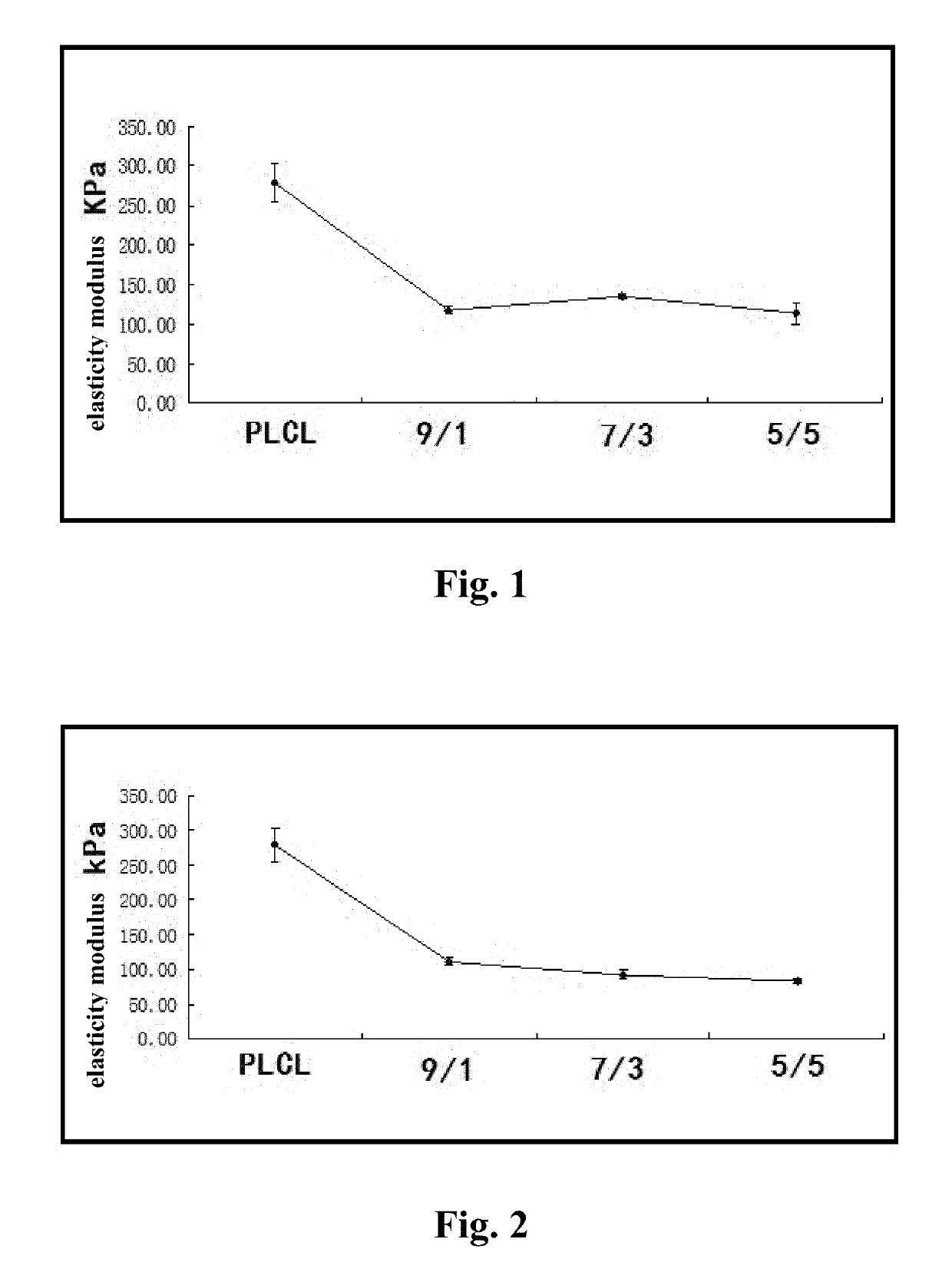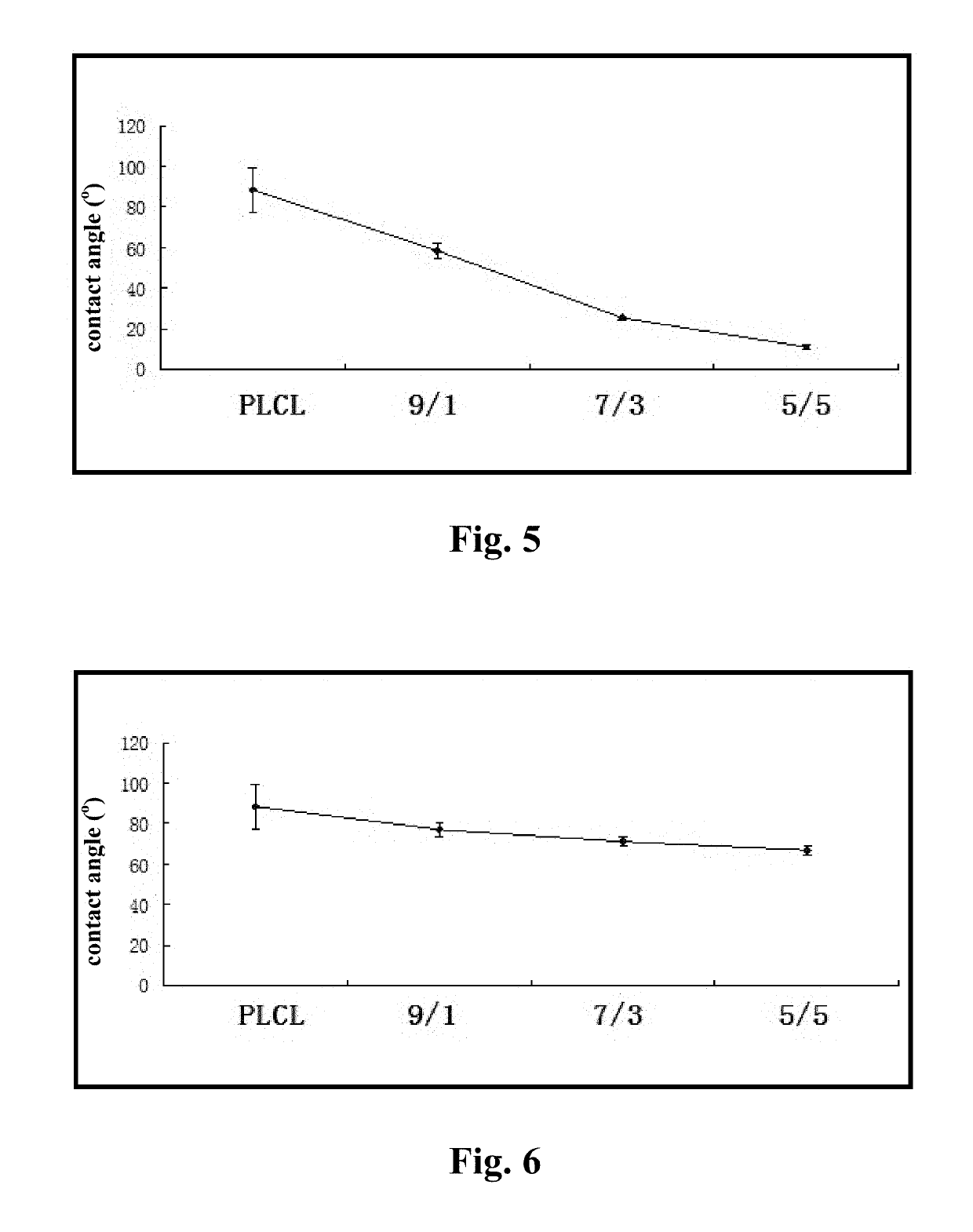Repair material with multi-purpose for abdominal wall hernia
a technology of abdominal wall and repair material, applied in the field of medical consumables, can solve the problems of connecting problems, inconvenient simple non-degradable mesh, chronic pelvic pain, etc., and achieve the effects of improving healing effects, reducing material rigidity, and improving water absorption of absorbable membran
- Summary
- Abstract
- Description
- Claims
- Application Information
AI Technical Summary
Benefits of technology
Problems solved by technology
Method used
Image
Examples
embodiment 1
[0040]Preferred Embodiment 1
[0041]1) Solution Preparation
[0042]1-1) material: PLCL, MPEG2000-PLLA6000, acetone.
[0043]1-2) equipment: 1000 ml flask, 250 ml cylinder, 250 ml conical flask.
[0044]1-3) environment: class 100,000 workshop.
[0045]1-4) equipments are processed with dry heat sterilization at 165° C. for 2 h, and are washed with acetone before using.
[0046]1-5) preparing 10 g MPEG2000-PLLA6000 and opening after reaching a room temperature, pouring into a 1000 ml flask, and adding acetone; sealing the flask and placing in an environment of 40° C. for dissolving; then adding 90 g PLCL and thoroughly stirring, and adding the acetone for reaching a volume of 1000 mL, wherein a mixed solution obtained is for later use (a mass ratio between the PLCL and the MPEG2000-PLLA6000 is 9:1).
[0047]2) Membrane Preparation
[0048]2-1) material: the mixed solution.
[0049]2-2) equipment: 50 ml cylinder, 100 ml cylinder, tweezers, ePTFE board.
[0050]2-3) environment: humidity: <20%; temperature: room ...
embodiment 3
[0070]Preferred Embodiment 3
[0071]1) Solution Preparation
[0072]1-1) material: PLCL, MPEG2000-PLLA6000, acetone.
[0073]1-2) equipment: 1000 ml flask, 250 ml cylinder, 250 ml conical flask.
[0074]1-3) environment: class 100,000 workshop.
[0075]1-4) equipments are processed with dry heat sterilization at 165° C. for 2 h, and are washed with acetone before using.
[0076]1-5) preparing 50 g MPEG2000-PLLA6000 and opening after reaching a room temperature, pouring into a 1000 ml flask, and adding acetone; sealing the flask and placing in an environment of 40° C. for dissolving; then adding 50 g PLCL and thoroughly stirring, and adding the acetone for reaching a volume of 1000 mL, wherein a mixed solution obtained is for later use (a mass ratio between the PLCL and the MPEG2000-PLLA6000 is 5:5).
[0077]2) Membrane Preparation
[0078]2-1) material: the mixed solution.
[0079]2-2) equipment: 50 ml cylinder, 100 ml cylinder, tweezers, ePTFE board.
[0080]2-3) environment: humidity: <20%; temperature: room ...
embodiment 4
[0085]Preferred Embodiment 4
[0086]1) Solution Preparation
[0087]1-1) material: PLCL, MPEG5000-PLLA5000, acetone.
[0088]1-2) equipment: 1000 ml flask, 250 ml cylinder, 250 ml conical flask.
[0089]1-3) environment: class 100,000 workshop.
[0090]1-4) equipments are processed with dry heat sterilization at 165° C. for 2 h, and are washed with acetone before using.
[0091]1-5) preparing 10 g MPEG5000-PLLA5000 and opening after reaching a room temperature, pouring into a 1000 ml flask, and adding acetone; sealing the flask and placing in an environment of 40° C. for dissolving; then adding 90 g PLCL and thoroughly stirring, and adding the acetone for reaching a volume of 1000 mL, wherein a mixed solution obtained is for later use (a mass ratio between the PLCL and the MPEG5000-PLLA5000 is 9:1).
[0092]2) Membrane Preparation
[0093]2-1) material: the mixed solution.
[0094]2-2) equipment: 50 ml cylinder, 100 ml cylinder, tweezers, ePTFE board.
[0095]2-3) environment: humidity: <20%; temperature: room ...
PUM
| Property | Measurement | Unit |
|---|---|---|
| thickness | aaaaa | aaaaa |
| area | aaaaa | aaaaa |
| thickness | aaaaa | aaaaa |
Abstract
Description
Claims
Application Information
 Login to View More
Login to View More - R&D
- Intellectual Property
- Life Sciences
- Materials
- Tech Scout
- Unparalleled Data Quality
- Higher Quality Content
- 60% Fewer Hallucinations
Browse by: Latest US Patents, China's latest patents, Technical Efficacy Thesaurus, Application Domain, Technology Topic, Popular Technical Reports.
© 2025 PatSnap. All rights reserved.Legal|Privacy policy|Modern Slavery Act Transparency Statement|Sitemap|About US| Contact US: help@patsnap.com



